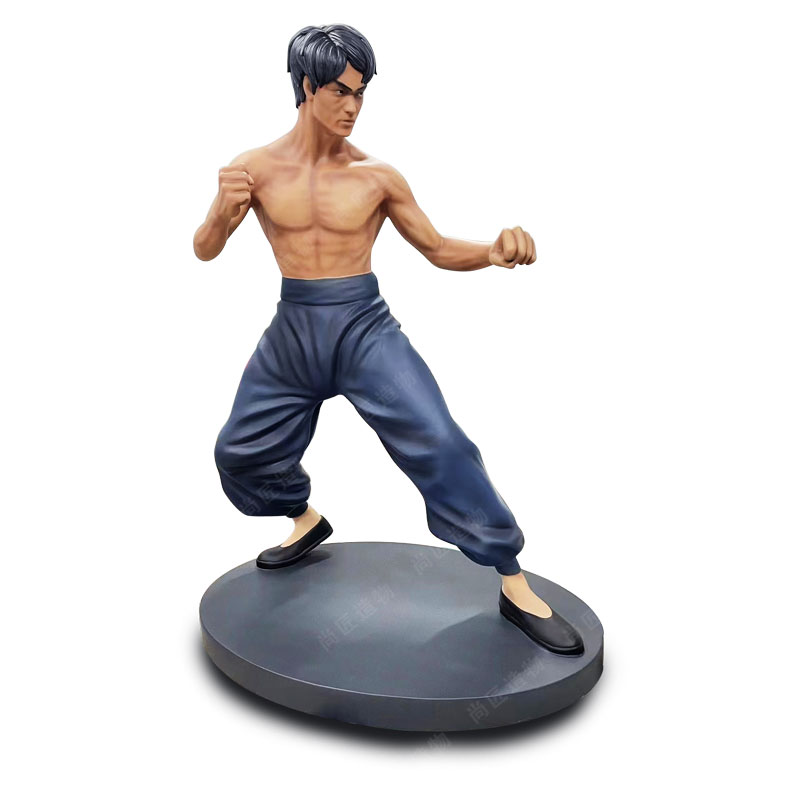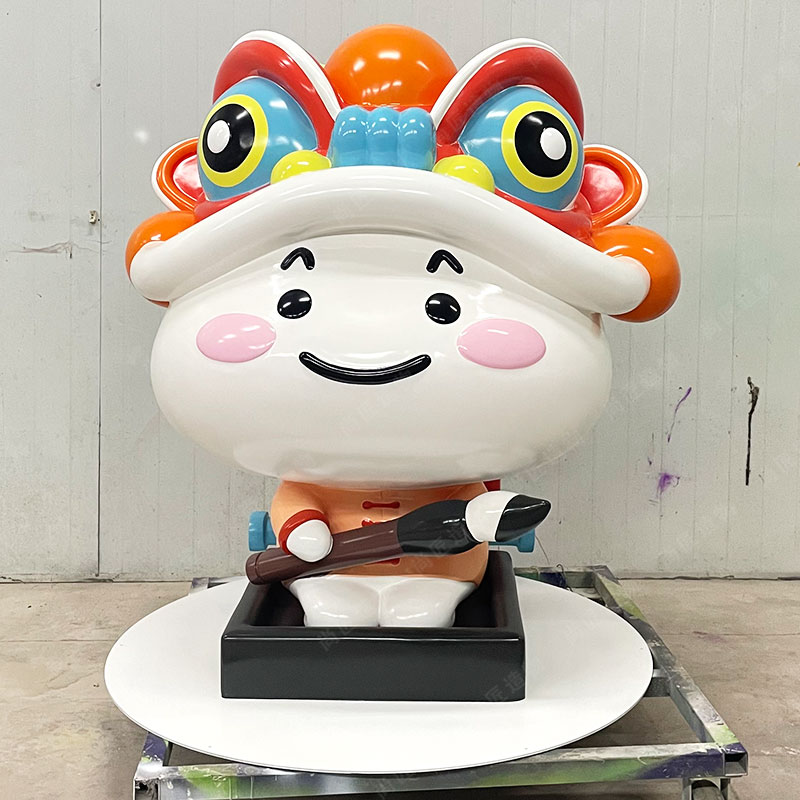Key Takeaways
Fiberglass sculptures have emerged as a leading solution for rust-resistant outdoor art, combining durability with aesthetic flexibility. Unlike traditional metals, fiberglass-reinforced polymer (FRP) resists corrosion, even in coastal or humid environments, while maintaining structural integrity for decades.
"Fiberglass allows artists to prioritize both longevity and creativity—something metals often compromise due to oxidation risks." — Public Art Conservator, Lena Torres
A comparative analysis highlights key advantages:
| Feature | Fiberglass | Metal |
|---|---|---|
| Rust Resistance | Inherently non-corrosive | Requires coatings/treatments |
| Weight | Lightweight (easier to install) | Heavy (needs reinforcements) |
| Maintenance | Low (annual cleaning) | High (frequent refinishing) |
| Cost Efficiency | Lower lifetime expenses | Higher upkeep costs |
When considering harsh climates, fiberglass outperforms metals through its weatherproof resin layers, which shield pigments from UV fading and moisture penetration. This makes it ideal for installations in rain-prone or high-salinity areas.
Tip: For optimal finish preservation, gently clean fiberglass sculptures with mild soap and water to prevent dirt buildup.
Transitioning from industrial applications to artistic use, fiberglass’s moldability supports intricate designs without sacrificing rust resistance. Its adaptability addresses both functional demands (e.g., load-bearing capacity) and creative possibilities (e.g., vibrant color retention), positioning it as a sustainable alternative to oxidation-prone metals.

Fiberglass vs Metal Sculpture Durability
When evaluating outdoor art longevity, fiberglass sculptures demonstrate distinct advantages over traditional metal counterparts. Unlike iron or steel, which require protective coatings to delay oxidation, fiberglass’s non-porous matrix inherently resists moisture penetration—a primary catalyst for rust. This structural resilience allows fiberglass installations to withstand decades of exposure to rain, humidity, and coastal salt spray without corrosion-related degradation. Metal artworks, while initially robust, often develop surface pitting or structural weakening over time, necessitating costly repairs or replacements.
Fiberglass’s flexibility further enhances durability in fluctuating temperatures. Unlike rigid metals that expand and contract, leading to stress fractures, fiberglass composites adapt to thermal shifts without compromising integrity. This adaptability makes it ideal for installations in regions with extreme seasonal variations. Maintenance demands also differ significantly: fiberglass retains vibrant finishes with minimal cleaning, whereas metal sculptures frequently require recoating to prevent rust stains or finish erosion. For projects prioritizing low upkeep and lasting aesthetics, such as Cartoon sculpture installations in public spaces, fiberglass offers a practical balance of artistic detail and environmental endurance.
Weatherproof Art Material Comparisons
When selecting materials for outdoor sculptures, artists and designers weigh durability against aesthetic flexibility. Traditional metals like bronze and steel, while valued for their strength, face inherent vulnerabilities to corrosion—particularly in coastal or humid environments. Protective coatings can delay rust, but regular maintenance remains essential to preserve structural integrity. Fiberglass, by contrast, resists oxidation entirely due to its non-metallic composition, eliminating rust-related deterioration. Its layered construction—combining resin with glass fibers—creates a moisture-resistant barrier that withstands temperature fluctuations, UV exposure, and chemical pollutants.
Unlike metals, which often develop patinas or require repainting, fiberglass retains vibrant finishes through advanced gel-coat applications. This material also offers weight advantages, reducing installation costs and enabling larger-scale designs without compromising stability. For example, IP character sculpture installations in public spaces increasingly favor fiberglass for its ability to maintain sharp details and bold colors despite years of exposure. While metals remain iconic in art history, fiberglass provides a pragmatic alternative for projects prioritizing longevity and visual consistency in challenging climates.

Rust-Resistant Outdoor Sculpture Solutions
Outdoor sculptures face relentless exposure to moisture, temperature fluctuations, and pollutants, making rust resistance a critical factor for longevity. While traditional metals like iron or steel require protective coatings to delay corrosion, modern solutions like fiberglass eliminate this vulnerability entirely. Unlike stainless steel sculptures, which rely on alloy composition to resist oxidation, fiberglass sculptures are inherently non-reactive. This synthetic material combines resin and glass fibers, creating a seamless barrier against water infiltration and electrochemical reactions that cause rust.
The structural flexibility of fiberglass allows artists to replicate intricate metallic textures while avoiding maintenance-intensive upkeep. For example, outdoor installations in coastal areas benefit from fiberglass’s saltwater resistance, a challenge even for some treated metals. Additionally, the material’s lightweight nature simplifies installation and reduces long-term structural stress on mounting surfaces. By prioritizing material science, artists and architects can achieve both aesthetic precision and functional resilience, ensuring public artworks remain visually intact for decades without compromising on design complexity.
Fiberglass Advantages in Harsh Environments
Fiberglass sculptures excel in environments where traditional metals falter due to corrosion and structural degradation. Unlike iron or steel, which require protective coatings to delay rust, fiberglass inherently resists moisture, salt, and chemical exposure. This non-metallic composite material maintains its structural integrity even when subjected to extreme temperature fluctuations, heavy rainfall, or coastal humidity. Its lightweight nature reduces stress on mounting systems, while its flexibility allows it to withstand impacts that might dent or crack rigid metals. For instance, kinetic sculptures leveraging fiberglass can endure constant motion without fatigue-related corrosion—a common issue with metal counterparts.
Additionally, fiberglass’s layered construction enables precise reinforcement in high-stress areas, ensuring longevity in windy or seismic zones. UV-resistant gel coatings further protect against sun-induced fading, preserving vibrant colors without frequent repainting. These properties make fiberglass a practical choice for public art in urban settings, coastal installations, or regions with harsh winters, where metal upkeep becomes costly and labor-intensive. By combining durability with design versatility, fiberglass addresses both functional and aesthetic demands in challenging outdoor conditions.

Maintaining Vibrant Sculpture Finishes Outdoors
Unlike traditional metal sculptures, which require frequent refinishing to combat rust and fading, fiberglass offers inherent advantages for preserving color integrity in outdoor settings. Its non-porous surface resists moisture absorption, a primary cause of oxidation in metals, while advanced UV-stable gel coatings shield pigments from solar degradation. For example, realistic sculpture designs using fiberglass maintain lifelike details and hues for decades, even in coastal or high-humidity environments.
Maintenance focuses on simple cleaning rather than intensive repairs: mild soap and water remove dirt buildup without damaging the finish, and optional automotive-grade waxes can enhance gloss retention. This contrasts with metal alternatives, where patinas or paint layers demand periodic stripping and reapplication. By eliminating corrosion risks, fiberglass ensures that artistic visions—from bold abstract forms to intricate figurative works—remain visually striking with minimal intervention, aligning with modern demands for sustainable public art.
Cost-Effective Rust-Free Art Innovations
Fiberglass sculptures have emerged as a groundbreaking solution for artists and institutions seeking durable, rust-resistant installations without compromising affordability. Unlike traditional metals like bronze or steel, which require costly anti-corrosion treatments and frequent upkeep, fiberglass inherently resists oxidation, slashing long-term maintenance expenses. Its lightweight composition further reduces installation and transportation costs, making large-scale projects more accessible. For example, public art initiatives increasingly opt for fiberglass due to its ability to withstand harsh weather while retaining structural integrity—eliminating the need for pricey protective coatings or replacements.
Additionally, the material’s adaptability allows for intricate designs at lower production costs compared to metal casting. Artists can experiment with bold forms and vibrant finishes without worrying about degradation, ensuring that aesthetic quality remains intact for decades. This economic advantage extends to private collectors and municipalities alike, offering budget-friendly alternatives to high-maintenance metalworks. By integrating fiberglass sculpture into outdoor spaces, stakeholders achieve lasting visual impact while reallocating resources toward creative expansion rather than preservation. The shift toward fiberglass underscores a broader trend in art innovation: balancing fiscal responsibility with uncompromising durability.
Fiberglass Artistry for Long-Lasting Installations
Fiberglass sculptures excel in outdoor settings by combining artistic flexibility with structural resilience. Unlike metals, fiberglass resists corrosion, ensuring installations withstand decades of exposure to rain, humidity, and temperature fluctuations. Artists favor this material for its ability to replicate intricate details—from flowing organic shapes to sharp geometric patterns—without compromising durability. The lightweight nature of fiberglass simplifies installation, reducing the need for heavy support structures while maintaining stability in high winds or extreme weather.
Additionally, fiberglass requires minimal upkeep compared to traditional metals. Its non-porous surface prevents moisture absorption, eliminating risks of rust or surface degradation. Modern coatings infused with UV inhibitors further preserve color vibrancy, preventing fading even under direct sunlight. This adaptability allows creators to focus on innovative designs rather than maintenance, making fiberglass a practical choice for public spaces, gardens, and architectural accents. By merging artistic ambition with engineering precision, fiberglass redefines how enduring outdoor art can coexist with environmental challenges.
Eco-Friendly Alternatives to Metal Sculptures
Fiberglass sculptures present a sustainable solution for artists and institutions seeking environmentally conscious alternatives to traditional metalwork. Unlike metals such as steel or iron, which rely on resource-intensive mining and refining processes, fiberglass production consumes significantly less energy and generates fewer greenhouse emissions. This material’s lightweight nature also reduces transportation-related carbon footprints, making it a practical choice for large-scale or remotely installed artworks.
Additionally, fiberglass’s resistance to rust eliminates the need for toxic anti-corrosion coatings or frequent replacements, further minimizing environmental harm. Its durability ensures that sculptures remain intact for decades, reducing waste associated with degraded or discarded pieces. Many modern fiberglass composites incorporate recycled materials, aligning with circular economy principles. For public art projects aiming for LEED certification or other sustainability benchmarks, fiberglass offers a versatile medium that balances artistic ambition with ecological responsibility.
By transitioning to fiberglass, creators can maintain aesthetic integrity while addressing growing demands for eco-friendly practices in outdoor art installations. This shift reflects broader trends in merging innovation with environmental stewardship across creative industries.
Conclusion
Fiberglass sculptures have redefined the standards for rust-resistant art by addressing the limitations of traditional metal materials. Unlike metals, which require constant maintenance to combat corrosion, fiberglass offers inherent resistance to moisture, temperature fluctuations, and environmental pollutants. This durability ensures that outdoor installations retain their structural integrity and visual appeal over decades, even in coastal or humid climates. Additionally, the material’s versatility allows artists to achieve intricate designs without compromising on weatherproofing or color retention. As cities and institutions prioritize long-term sustainability, fiberglass emerges as a practical choice, reducing the need for costly repairs or replacements. Its lightweight nature further simplifies installation and transportation, making it accessible for both large-scale public projects and private collections. While metals remain iconic in art history, fiberglass provides a forward-looking solution that balances artistic ambition with ecological and economic efficiency. This shift underscores a broader trend toward materials that harmonize creativity with resilience, ensuring art endures as a dynamic part of urban and natural landscapes.

Frequently Asked Questions
How does fiberglass prevent rust compared to traditional metals?
Fiberglass sculptures lack iron content, eliminating oxidation risks inherent in steel or iron-based artworks. Their composite structure resists moisture absorption, a primary catalyst for metal corrosion.
What makes fiberglass suitable for harsh outdoor environments?
The material’s non-porous surface, combined with UV-resistant gel coatings, shields against weathering elements like rain, salt spray, and temperature fluctuations. Unlike metals, it doesn’t expand or contract significantly, reducing structural stress.
Are fiberglass sculptures more expensive than rust-resistant metal alternatives?
Initial costs may align with premium alloys like stainless steel, but fiberglass requires less maintenance over time. Eliminating expenses for anti-rust treatments or protective coatings improves long-term cost efficiency.
Can fiberglass replicate detailed metallic finishes without tarnishing?
Advanced pigmentation techniques embed color within the resin matrix, preserving vibrancy without oxidation. Metallic-effect topcoats mimic brass, bronze, or steel aesthetics while remaining impervious to patina development.
How long do fiberglass outdoor sculptures typically last?
Properly sealed installations maintain structural integrity for 20-30 years, outperforming untreated metals in humid or coastal zones. Regular cleaning and periodic waxing can extend this lifespan further.
Is fiberglass environmentally friendly compared to metal sculpture production?
Fiberglass manufacturing consumes less energy than smelting ores for metals. Additionally, its durability reduces replacement frequency, lowering resource consumption across the artwork’s lifecycle.
 ch
ch English
English






